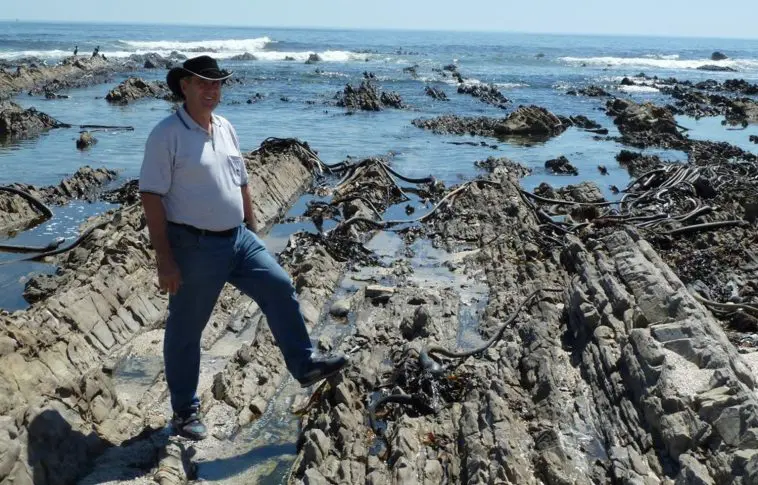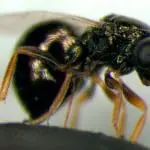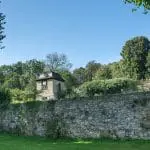[Originally published as Cape Town’s oldest rocks deposited rapidly from abundant water]
The oldest rocks in the Cape Town area, South Africa, are part of the Malmesbury Group,1 named after the town of Malmesbury, 60 km north-west of Cape Town. The Malmesbury Group covers a large area around Cape Town: 200 km to the north and 100 km to the east. Beyond this, they are covered by the younger sediments of the Cape Supergroup.2 Unaltered exposures are rare because they weather quickly and are frequently covered by sand and soil. However, some good outcrops can be found near Cape Town along the shore at Sea Point.
The Malmesbury group consists of a collection of diverse rock formations that are separated from each other across the area by major faults. Further, the formations have been folded and eroded, all of which prevents the relationships between the different formations from being worked out, or their thicknesses. A tentative estimate for the thickness of the group is more than 6 km.3
The rocks that are exposed around Cape Town are part of the Tygerberg Formation, named after the Tygerberg Hills north of Bellville. The formation consists of alternating beds of greywacke (a muddy sandstone), siltstone, mudstone, and quartzite.4
There are many features of these rocks that point to the beds being rapidly deposited from flowing water, such as:
- The sand grains of the greywacke are angular to poorly rounded,4 indicating that the sediments were deposited soon after they were eroded without time for the grains to be rubbed together and their sharp edges removed.
- The grains in the greywacke are poorly sorted—they have an assortment of different sizes. The grains are supported in a fine matrix of clay.4 This indicates that the sediments were deposited quickly without time for water to sort the grains into different sizes and wash away the mud and clay.
- The greywacke includes grains of the minerals plagioclase and microline,4 indicating that the sediments were not exposed to prolonged weathering, which would break down these minerals.
- In places, the beds display cross bedding and graded bedding, indicating they were deposited from flowing water.5
- The surfaces of the beds preserve current ripple marks, indicating flowing water.6
- The bed can be quite thick, up to 0.5 m to 2.0 m,4 with some as large as 3 m.8 This points to considerable volumes of flowing water.
- Slumping and other soft sediment deformation features are present at several localities,5 indicating that sedimentation was rapid.
- Turbidite characteristics have been identified in some zones,5 indicating that the beds of sediment were laid down as density flows — like an underwater avalanche. In a turbidite flow, the speed of the water current can exceed 50 km per hour.
- The beds have abundant fine depositional layers called ripple cross laminations.5 This indicates that deposition of beds one upon the other occurred before the surfaces could be colonized with worms and burrowing animals that would destroy fine structures.8
- The rocks of the Malmesbury Group cover a large area, indicating that the processes involved in deposition were of a large geographic scale.
The characteristics of the oldest rocks in the Cape Town area, South Africa, point to rapid sedimentation from abundant, fast-flowing water over a large geographical area. This is consistent with the scale of processes that we would expect during the global Flood of Noah’s day.
As geologists, we don’t point to these characteristics and say that they prove Noah’s Flood, any more than uniformitarian geologists point to these characteristics to prove uniformitarianism. These are two different interpretive geological frameworks. Both are assumed, and the evidence is explained from within that framework. And indeed, the evidence that we see fits nicely within the biblical framework.
From a biblical perspective, I would assign these Malmsbury Group sediments to the first ‘half’ of the Flood as the waters were rising on the earth. These are not the first rocks or sediments to be deposited in the Flood, and they are not the last. Above the Malmsbury Group, there is a huge volume of sediment that was deposited afterward, but while the floodwaters were still rising, including the 7-km-thick sediment pile of the Cape Supergroup and the sediments of the Karoo Sequence, also kilometres thick.
References and Notes
- Compton, J.S., The Rocks and Mountains of Cape Town, Double Storey Books, pp. 44–45, 2004.
- McCarthy, T. and Rubidge, B., The Story of Earth and Life: A Southern African Perspective, Struik Nature, Cape Town, p. 16, 2005.
- Theron, J.N., Gresse, P.G., Siegfried, H.P. and Rogers, J., The Geology of the Cape Town Area, Department of Mineral and Energy Affairs, Republic of South Africa, pp. 5–6, 1992.
- Theron, et al., ref. 3, p. 7.
- Theron, et al., ref. 3, p. 8.
- Theron, et al., ref. 3, pp. 8–9.
- Theron, et al., ref. 3, p. 9.
- Compton, ref. 1, p. 45 notes that the preservation of the fine laminations indicates the absence of burrowing animals, but he says that is because worms had not yet evolved. The Malmsbury Group is assigned to the Precambrian, an age of 540–560 million years within the evolutionary framework and does not contain fossils. That is, it has been assigned to the Ediacarin Sytem and, from an evolutionary perspective, there were sea-floor organisms around at that time. In other words, the absence of fossils does not mean the animals did not exist. Take as an example the overlying Graafwater and Peninsula Formations, which have been dated as Late Cambrian to Ordovician (Compton, p. 59) when life had already evolved, according to the evolutionary view. These formations lack useful fossils (Compton, p. 61), so the absence of fossils does not mean the animals did not exist.
Further reading
- Compton, J.S., The Rocks and Mountains of Cape Town, Double Storey Books, 112 pp., 2004.
- Theron, J.N., Gresse, P.G., Siegfried, H.P. and Rogers, J., The Geology of the Cape Town Area, Department of Mineral and Energy Affairs, Republic of South Africa, 140 pp,. 1992.
- McCarthy, T. and Rubidge, B., The Story of Earth and Life: A Southern African Perspective, Struik Nature, Cape Town, 334 pp., 2005.






